
THE PRODUCT:
Furnace fans circulate air heated by a furnace through a home’s duct system into the living space. For homes with central air conditioning, the furnace fan also serves to circulate conditioned air during the cooling season.
THE STANDARD:
The current standards for furnace fans took effect in 2019 and are the first efficiency performance standards for these products. The standards specify a maximum fan energy rating (FER) that varies based on the airflow delivered by the furnace fan. For most furnace fans, the standards effectively require the use of efficient brushless permanent magnet (BPM) motors, which reduce electricity consumption by about 50% compared to conventional permanent split capacitor (PSC) motors.
In 2023, DOE published a notice of proposed determination (NOPD) that tentatively determined that amended standards for furnace fans are not warranted.
*FER is expressed in terms of power consumption (W) per delivered airflow (1000 CFM) and incorporates energy consumption in three different modes: heating, cooling, and constant circulation.
KEY FACTS:
Furnace fans are among the largest users of electricity in a typical household. Prior to the current standards taking effect, most furnace fans, utilizing inefficient PSC motors, consumed about 1,000 kWh of electricity per year on average, or nearly 10% of an average household’s electricity use.
Filings
ASAP Press Releases
Reports
Standards in the News
Timeline
| Federal | Date |
| Proposed Negative Determination Issued | 2023 |
| 1st Federal Standard Effective | 2019 |
| 1st Federal Standard Adopted | 2014 |
| EPACT Initial Federal Legislation Enacted | 2005 |